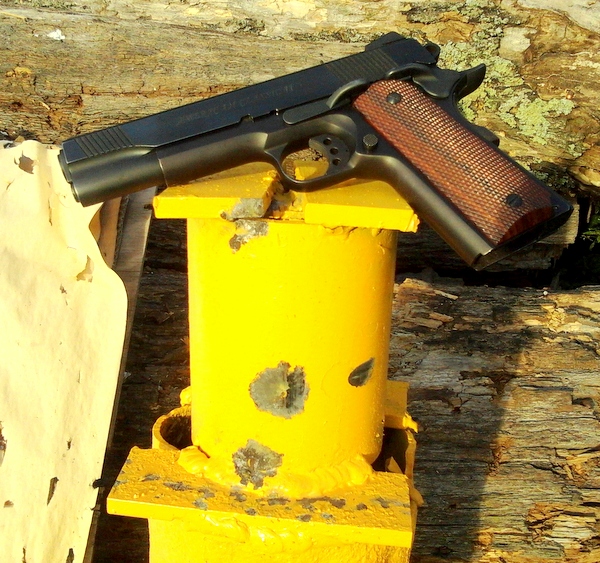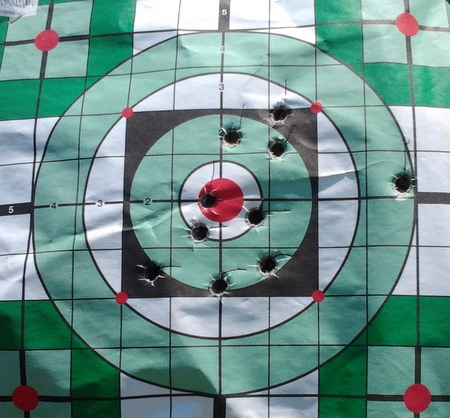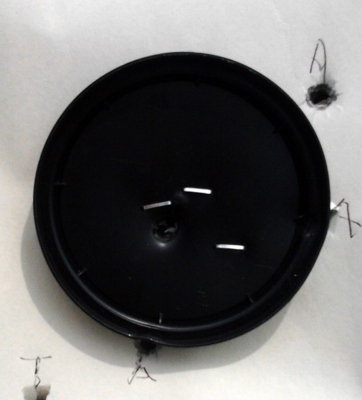The Metroarms American Classic II 1911 Pistol

Five rested shots at 50 yards, on the 4×6 inch head of a steel torso target- after installing a 0.001″ over fitted barrel bushing.
One of my contorted gun trades recently yielded a lightly-used Metro Arms “American Classic II Government Model” 1911. I knew nothing of Metro Arms until I stumbled onto this one, but some web surfing indicates they are essentially a best-grade Philippine 1911-A1. I read everything I could find on them and it’s difficult to find a bad review. This 45 Auto has a decent blue finish and about every add-on to a 1911 that renders it non-GI. If you’ve read much of my 1911 stuff you are aware that I don’t like any of that crap on a 1911; but I’ll admit some fondness for this one. That fondness is based on performance. At this writing the American Classic II has flawlessly digested over 700 rounds of various FMJ, JHP and reloads. It’s hard not to like any 1911 that runs like a Swiss watch and groups five rounds of damn near anything into 1 1/2 to 2 inches, at 25 yards.
I was able to field strip and inspect the American Classic II before acquiring it. Everything I saw was far better than what I usually find in 1911’s at this price point. Ozark Gun & Pawn is well out of town and they have a steel IDPA silhouette standing 35 yards out their back door. Ringing it with the full mag was downright easy and confirmed the pistol shot where it looked.
When time permitted, I detail stripped the Classic II in my usual search to find all the things the manufacturer screwed up. To my surprise, I found almost nothing that needed improvement. The gun is exceptionally well-fitted and racking the slide with the barrel & bushing removed confirms this.
These 1911’s have a forged slide and barrel, which means the barrel one-piece as opposed to the pressed & soldered two piece tubes now common on a supposedly better brand or two. The barrel has shallow rifling and its muzzle diameter is just shy of .580”., with a .005” reduction along the main tube for proper functional clearance. It has a good throat and its bushing is .003” larger than muzzle diameter.
The little firing wear present showed the barrel bedding perfectly to the frame, with the bottom of the lower lugs just kissing the slide stop crosspin, which measures 0.1995”. The extractor is a quality part, properly dimensioned and with well executed bevels in the right places. Trigger & thumb safety action are real decent, which also indicate careful fitting. In short, I found lots of positives and very few negatives. The hammer is weird-looking but easily replaced. I’ve worked on a few ‘Loaded’ Springfield 1911’s and in all honesty, the Metro compares favorably with them. This pistol came with a crisp, 4 1/4 pound trigger and is real easy to shoot well.
I fired a few groups from sitting position with the gun rested over one knee. My 25 yard position was a swamp at the time, so I shot from about 30 yards. This is two separate 5 shot groups; vertical hash marks indicate the front sight held on the dot. Horizontal hash marks in a hold on the bottom of the black square surrounding it. This was on a real windy day, so fliers were inevitable. But the better clusters from each group tell me the pistol is grouping between 1 ½ to 2 inches with plated-bullet reloads in range mongrel brass. I consider it pretty good under the conditions

This is two separate 5 shot groups at 30 yards on a windy day. Vertical hash marks indicate the front sight held on the dot. Horizontal hash marks in a hold on the bottom of the black square surrounding it. Xtreme plated-bullet reloads in range mongrel brass.
End-User Improvements
The grips that came on the Classic II were of the ‘double diamond’ pattern, of some sort of Philippine soft wood with a very poor finish. I slapped on an old set of checkered Ajax Cocobolos I had laying around. The OEM link measured .283 and I replaced it with a Wilson #3 (.278”) which improved lower lug engagement. It took a little shooting to seat the parts, but accuracy began to improve.
This is all fine, but the average 50 yard group was still 6-7 inches and I wanted to improve that. A local surplus parts dealer had a 0.581” barrel bushing with a 0.695” skirt. I placed the bushing skirt-first over a long and well-oiled tapered punch and drove it down to increase the diameter. I turned it down until it was hard fit to the slide. 50 yard groups shrank to 3 ½” with almost any 45 ACP ammo, as seen in the photo at the top of the page. There is no earthly reason for a shallow-rifled barrel to shoot this well- but it does.
Observations and Subsequent Product Improvements
The slide to frame fit on this pistol is top notch and it would be a good candidate for a bullseye gun, or so I thought. I set about shopping for a barrel. A local parts dealer was good enough to let me sit down with my slide, a set of micrometers and about 35 Colt GI, Commercial or National Match barrels he had on hand. They were all too short in the hood. My Metro Arms barrel has a 0.165″ hood and a slide cut to match.
I called one of Eagle Imports primary service centers here in the US and the owner was very candid about improvements to the Metro Arms 1911’s over the years. Metro Arms Corporation was established in the Philippines by former competitive shooter, Hector Rodriquez. Mr. Rodriquez set out to build a top-notch 1911 from the get-go; but let’s let him speak for himself.
My source indicates Mr. Rodruquez been very responsive to input from professional American gunsmiths, who service his products. Minor divergences from the USGI specs were noted early on and reported to Metro Arms. Metro’s commitment to offer exceptional 1911’s insured they were noted and changes were made. I am assured that current production Metro Arms 1911’s, which use conventional barrels, will accept any barrel intended for the Colt 1911.
I am also informed that the later, improved pistols with a three-digit prefix to their serial number. It turns out that I have an early gun that was built before Metro Arms completely standardized on USGI specs. Regardless, my early example is stone reliable and shoots better than 95% of shooters can hold it- author included.
You folks know how picky I am about 1911’s. I think these Metro Arms American Classics are excellent pistols and I don’t think they can be beat at the price point.


Dale Flowers
Good article. Think I’ll bid on a Metro Arms 1911 American Classic I see at Gunbroker sitting pretty cheap right now.
Sarge author
Thank you my friend. I hope yours is as good as mine was.
charles
I Love my Metro Arms, it’s practically indestructible! It’s been dropped in almost every medium you can imagine, and still fires 100% of the time. My house was burned to the ground a while back along with my .45. It was inside it’s leather holster, and the only damage it incurred (rust), was caused by the water from the fire department hoses. All but three of my firearms were reduced to blobs of polymer and aluminum slag. After a little cleaning and oiling, it shoots fine. You can’t beat the quality for the money!